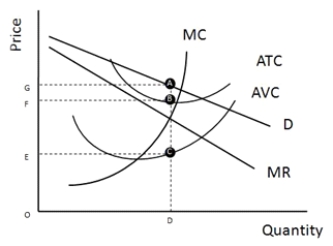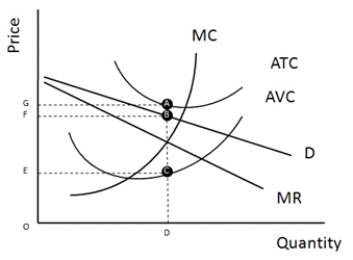A) by producing at a level where marginal cost equals marginal revenue
B) by producing at a level where average variable cost equals average revenue
C) by producing at a level where average total cost equals average revenue
D) by producing at a level where average variable cost equals marginal cost
F) B) and C)
Correct Answer

verified
Correct Answer
verified
True/False
Monopolistically competitive firms are capable of earning long-run profits due to product differentiation.
B) False
Correct Answer

verified
Correct Answer
verified
Multiple Choice
What are oligopolists said to be doing when they determine price and output decisions jointly?
A) corroborating
B) combining
C) coexisting
D) colluding
F) A) and D)
Correct Answer

verified
Correct Answer
verified
True/False
Prisoner's Dilemma is the classic game with a dominant strategy that demonstrates the basic problem faced by noncolluding oligopolists.
B) False
Correct Answer

verified
Correct Answer
verified
Multiple Choice
Two restaurants, in a small town, compete in the market for pizza. Each restaurant must decide whether to charge a high price or a low price. The potential monthly profits for these firms are shown below (in thousands of dollars) .
FIGURE 10-4
 -Referring to Figure 10-4, what is the cooperative outcome?
-Referring to Figure 10-4, what is the cooperative outcome?
A) Restaurant A charges a high price and Restaurant B charges a low price.
B) Restaurant A charges a low price and Restaurant B charges a high price.
C) Restaurant A charges a high price and Restaurant B charges a high price.
D) Restaurant A charges a low price and Restaurant B charges a low price.
F) C) and D)
Correct Answer

verified
Correct Answer
verified
Multiple Choice
What is the deadweight loss of monopolistic competition a result of?
A) barriers to entry
B) productive inefficiency
C) inelastic product demand
D) allocative inefficiency
F) C) and D)
Correct Answer

verified
Correct Answer
verified
Multiple Choice
FIGURE 10-1
 -The profit-maximizing firm illustrated in Figure 10-1 operates in a monopolistically competitive industry. What is this firm's total revenue equal to?
-The profit-maximizing firm illustrated in Figure 10-1 operates in a monopolistically competitive industry. What is this firm's total revenue equal to?
A) FGAB
B) OFBD
C) OECD
D) OGAD
F) B) and C)
Correct Answer

verified
Correct Answer
verified
Multiple Choice
Under what circumstances might advertising lead to a reduction in prices?
A) if marginal revenue increases faster than marginal costs
B) if it leads to increased awareness of substitutes and increased elasticity
C) if increased production leads to lower average costs
D) if it leads to increased differentiation and decreased elasticity
F) C) and D)
Correct Answer

verified
Correct Answer
verified
Multiple Choice
FIGURE 10-1
 -The profit-maximizing firm illustrated in Figure 10-1 operates in a monopolistically competitive industry. What is this firm's total fixed cost equal to?
-The profit-maximizing firm illustrated in Figure 10-1 operates in a monopolistically competitive industry. What is this firm's total fixed cost equal to?
A) FGAB
B) OFBD
C) OECD
D) EFBC
F) A) and C)
Correct Answer

verified
Correct Answer
verified
Multiple Choice
What is it referred to when two firms collude to improve their profit maximizations?
A) a cooperative game
B) a strategic game
C) an interdependent policy
D) a defensive policy
F) None of the above
Correct Answer

verified
Correct Answer
verified
True/False
Advertising always leads to a cost of production.
B) False
Correct Answer

verified
Correct Answer
verified
Multiple Choice
Why do oligopolists tend to change their price less frequently than perfect competitors?
A) because their demand curves are inelastic
B) because they often are subject to government price controls
C) because they are uncertain as to how their competitors will react
D) because the demand curve for their product is not as volatile
F) C) and D)
Correct Answer

verified
Correct Answer
verified
True/False
Monopolistically competitive firms set price equal to marginal cost.
B) False
Correct Answer

verified
Correct Answer
verified
Multiple Choice
Why do firms in monopolistically competitive industries have some degree of market power?
A) as a result of barriers to entry
B) as a result of economies of scale
C) as a result of specialization and division of labour
D) as a result of product differentiation
F) C) and D)
Correct Answer

verified
Correct Answer
verified
Multiple Choice
Under what circumstances might advertising benefit society?
A) if it provides information
B) if it decreases the deadweight loss from underallocation of resources
C) if it increases productive efficiency
D) if it increases allocative efficiency
F) A) and D)
Correct Answer

verified
Correct Answer
verified
Multiple Choice
FIGURE 10-1
 -The profit-maximizing firm illustrated in Figure 10-1 operates in a monopolistically competitive industry. What is this firm's total profit equal to?
-The profit-maximizing firm illustrated in Figure 10-1 operates in a monopolistically competitive industry. What is this firm's total profit equal to?
A) FGAB
B) OECD
C) EFBC
D) OFBD
F) All of the above
Correct Answer

verified
Correct Answer
verified
Multiple Choice
FIGURE 10-2
 -The profit-maximizing firm illustrated in Figure 10-2 operates in a monopolistically competitive industry. What is this firm's total profit equal to?
-The profit-maximizing firm illustrated in Figure 10-2 operates in a monopolistically competitive industry. What is this firm's total profit equal to?
A) OFBD - OGAD
B) OGAD - OFBD
C) OFBD
D) FGAB
F) B) and C)
Correct Answer

verified
Correct Answer
verified
True/False
Game theory examines how firms try to maximize their profits by making decisions based on the actions of their competitors.
B) False
Correct Answer

verified
Correct Answer
verified
Multiple Choice
When does excess capacity in an industry occur?
A) when quantity supplied exceeds quantity demanded
B) when quantity demanded exceeds quantity supplied
C) when economic profits are negative
D) when production occurs to the left of minimum average total cost
F) A) and B)
Correct Answer

verified
Correct Answer
verified
Showing 81 - 99 of 99
Related Exams